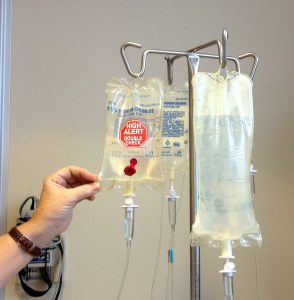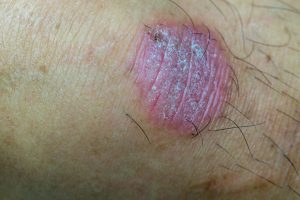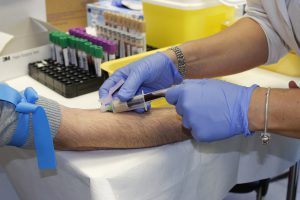Did you know that approximately 1 in 500 Americans are living with a stoma, or a surgical opening in the body created for the discharge of bodily waste? According to the United Ostomy Association, more than 500,000 Americans have had an ostomy, which is surgery that creates a stoma in order to treat certain diseases of the digestive or urinary tract. There are 3 different kinds of ostomies; colostomies are the most common type, and leave those who undergo the surgery with a colostomy bag to collect waste removed from their body. But are colostomy bags a temporary fix or are they permanent?
What Is A Colostomy?

A colostomy is surgery that removes a part of the colon that is diseased or has been damaged by illnesses like inflammatory bowel disease, including Crohn’s disease, ulcerative colitis, or diverticulitis. During the procedure, surgeons will create an opening, called a stoma, and bring out a portion of the large intestine through the belly so that waste has an alternative way to leave the body after the diseased part of the colon is removed. To collect that waste, a plastic pouch, or colostomy bag, will be fitted over the stoma to collect the stool that leaves through the opening.
This kind of surgery will keep you in the hospital for a few days to a week. While there, you will be taught how to change your colostomy bag and keep the skin around the stoma clean.
Is a Colostomy Bag Permanent?
There are 4 different types of colostomies, and the type of surgery you have will generally determine if your colostomy bag is going to be temporary or permanent. If the colostomy is performed due to injury, then in most cases the colostomy bag will be a temporary fix while your body heals. However, if you have colon cancer and you need to have surgery to remove your colon, the colostomy bag might be permanent.
 You can have a temporary colostomy bag for weeks, months, or even years depending on the condition. Your colostomy bag might become permanent if you are diagnosed with:
You can have a temporary colostomy bag for weeks, months, or even years depending on the condition. Your colostomy bag might become permanent if you are diagnosed with:
- Blockage
- Diverticulitis
- IBS
- Crohn’s disease
- Ulcerative colitis
- Colorectal cancer
- Abnormal growths in the colon called polyps
Caring For Your Colostomy Bag
In order to prevent leakage from your colostomy bag, The American College of Surgeons recommends changing the bag when it is between ⅓ and ½ full. How often you will need to change your colostomy bag will depend on the size of the bag: the smaller the bag, the more frequently you will have to change it, while bigger bags will need to be changed less often and can last overnight. When it is time to change the bag, you will need to :
- Wash your hands with antibacterial soap.
- Push down on your skin and peel the bag from the stoma.
- Remove the bottom of the bag and empty it into a toilet.
- Clean the stoma with a washcloth, warm water and soap.
- Pat the area dry.
- Attach the new bag with adhesive on the outside of the stoma.
Washing and drying the stoma completely is key to avoiding the most common problem of redness and soreness. If the skin is ever raw, red, or leaking fluid, you will need to contact your doctor right away.
Life With A Colostomy Bag

While being given a colostomy bag is a huge life change that can feel overwhelming in the beginning, you can still live a normal life with one. You will most likely be able to eat the same things you ate before, shower, take baths, have sex, and exercise after you get clearance from your doctor. As we stated, colostomies are more common than you think, but if you are embarrassed, uncomfortable, or just don’t want people to know that you have a colostomy bag, you can hide it. The pouches are small and flat enough to hide under your clothes, and they are made to trap odors. No one needs to know you have one, unless you want them to!
A health condition that requires a colostomy can occur at any time: you could get an infection or abscess, or an injury to your colon that causes a partial or complete blockage of the large bowel. In these cases, surgery, and a colostomy bag after the surgery, will be required in order to save your life, and if you do not have good health insurance, you will face a large bill.
Having the right health insurance plan can make a situation like this less scary, because you know you will get the best care and won’t have to worry about bills afterwards – after all, you will have enough on your plate adjusting to a colostomy bag!If you are looking to compare health insurance plans in your area, EZ can do so for free. We work with the top-rated insurance companies in the nation and can compare quotes and plans at no cost to you. We will find the best plan for your budget and medical needs. To get started, simply enter your zip code in the bar above, or to speak to a licensed agent, call 888-350-1890.







 So, to know how much you can save on your premiums, you’ll need to know where you fall on the Federal Poverty Line. If you’re not sure, EZ will figure that out for you, and then let you know what kind of subsidies you can expect to receive – you could save anywhere from $200 to $1,000 a month on premiums, and we’ll help you save more if possible. We will compare plans from different insurance companies to find a plan that meets your needs and saves you as much money as possible!
So, to know how much you can save on your premiums, you’ll need to know where you fall on the Federal Poverty Line. If you’re not sure, EZ will figure that out for you, and then let you know what kind of subsidies you can expect to receive – you could save anywhere from $200 to $1,000 a month on premiums, and we’ll help you save more if possible. We will compare plans from different insurance companies to find a plan that meets your needs and saves you as much money as possible!



